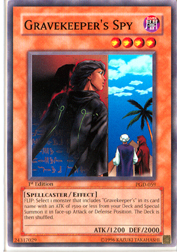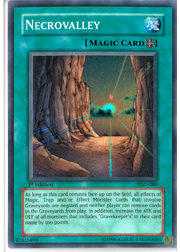 We’ve covered Gravekeeper decks before, but with the release of the Gold Series, Crush Card Virus is now becoming a widely played card. A Cat of Ill Omen has been a largely undervalued card, but in a deck packing Necrovalley and Crush Card Virus, it’s absolutely ridiculous. At Shonen Jump Championship Nashville 2008, Chioh Yim made the Top 16 with a Necrovalley Monarch deck. Another Gravekeeper deck, piloted by Torsten Hutzl made it to the Top 16 of the German National Championships. While Yim was only using Necrovalley as metagame tech, Hutzl was playing a dedicated toolbox version which is worth noting.
We’ve covered Gravekeeper decks before, but with the release of the Gold Series, Crush Card Virus is now becoming a widely played card. A Cat of Ill Omen has been a largely undervalued card, but in a deck packing Necrovalley and Crush Card Virus, it’s absolutely ridiculous. At Shonen Jump Championship Nashville 2008, Chioh Yim made the Top 16 with a Necrovalley Monarch deck. Another Gravekeeper deck, piloted by Torsten Hutzl made it to the Top 16 of the German National Championships. While Yim was only using Necrovalley as metagame tech, Hutzl was playing a dedicated toolbox version which is worth noting.
We’ll be considering a Gravekeeper deck that utilizes the Cat of Ill Omen ability to search your deck for a toolbox of traps. Against Gladiator Beast decks, we’ll be able to search the condemning Deck Devastation Virus, and against Dark Armed Dragon decks, we’ll be searching for Crush Card. We’ll be leaving our opponents drawing into nothing and with no hand rather quickly, which is a fun aspect whichever way you think about it.
The Monsters
We’ll be playing our Gravekeeper monsters with a touch of Monarchs to allow us the chance to remove pesky cards from the field. Notice t hat this deck’s greatest enemy is Shadow-Imprisoning Mirror, and that Gladiator Beasts have run it in the past. However, since it impedes Gyzarus, some Gladiator Beast builds have dropped it. We’ll have to rely on a sturdy side deck to take this card out, or a little luck during the first game.
hat this deck’s greatest enemy is Shadow-Imprisoning Mirror, and that Gladiator Beasts have run it in the past. However, since it impedes Gyzarus, some Gladiator Beast builds have dropped it. We’ll have to rely on a sturdy side deck to take this card out, or a little luck during the first game.
This monster lineup is incredibly fluid. If we open with Crush Card Virus or Deck Devastation Virus, Gravekeeper’s Spy is going to get us either an Assailant or Guard, depending on which trap card we have. Then, we have the "way too good to be played in the Advanced Format" Tsukuyomi, which is going to generate monsters, let us search our deck for traps repeatedly, and just allow for unfair situations.
If we can protect our Cat of Ill Omen, it can either search Crush Card and be tributed for its effect, or search Deck Devastation Virus and be tributed for Caius, who can then be tributed for Deck Devastation.
The Spells
The spell lineup in the Advanced format is much smaller, but the movement to the Traditional format offers us, more than anything else,  playable spell cards. We have more drawing power and more hand disruption than before, which allows for a faster control over the game.
playable spell cards. We have more drawing power and more hand disruption than before, which allows for a faster control over the game.
Obviously, we’re running the three Necrovalley cards that stitch this deck together, allowing our Cats to search for traps, our monsters to be tributed for the Viruses, and locking down nearly one-third of our opponent’s deck. We’re also running two copies of Allure of Darkness to let us put unplayable copies of Gravekeeper’s Guard to use.
Finally, notice that we’ll be playing Swords of Revealing Light. We’ll be playing its trap counterpart, Wall of Revealing Light, as well. This, along with our trap lineup, is going to help us keep our Cats on the field.
The trap lineup is a parabolic Swiss Army knife. We can search for  any card here with our A Cat of Ill Omen. Unlike most Traditional decks we’ve taken a look at, the trap lineup is where Gravekeeper decks really have their power.
any card here with our A Cat of Ill Omen. Unlike most Traditional decks we’ve taken a look at, the trap lineup is where Gravekeeper decks really have their power.
In the past, Gravekeepers was seen as an aggro deck, but it’s evolved to be played as a control deck. Remember to keep that in mind while testing this build: if you started the game recently, you’ve probably been playing in an aggro format, and didn’t benefit from playing in a format swarmed with three copies of Scapegoat. This is a different style of play, so if you want to see what a conservative control deck can do, try playing this one. It just might improve your game, no matter what deck or format you choose to play.
Playing Solemn Judgment and Dark Bribe takes a lot of skill in some situations, because they are both costly, and for some, difficult to activate at the right time. When considering negating your opponent’s cards, you’ll need to consider what your opponent has already played, how many cards you and your opponent have, what reads you have concerning your opponent’s unknown cards, what cards your opponent will most likely play, the life point counts, what would most likely result over the course of the next two or three turns if you play your counter trap, and perhaps the most difficult and obvious question, what one card your opponent really does not want you to negate. This thought process should, of course, be going through your mind with the activation of every card. Practicing with this deck might help you to develop those skills to improve your game play.
—Ryan Murphy